Analysis of Retail Sector Studies and Papers
VerifiedAdded on 2020/10/05
|18
|5018
|453
AI Summary
This assignment involves a thorough examination of multiple research papers related to the retail sector. It covers topics such as energy management in retail businesses, the impact of individual and organizational variables on environmentally friendly behaviors, social media's role in enhancing customer satisfaction, and service quality's influence on customer retention. The analysis provides insights into the challenges and opportunities facing retailers, making it a valuable resource for students and professionals in the field.
Contribute Materials
Your contribution can guide someone’s learning journey. Share your
documents today.
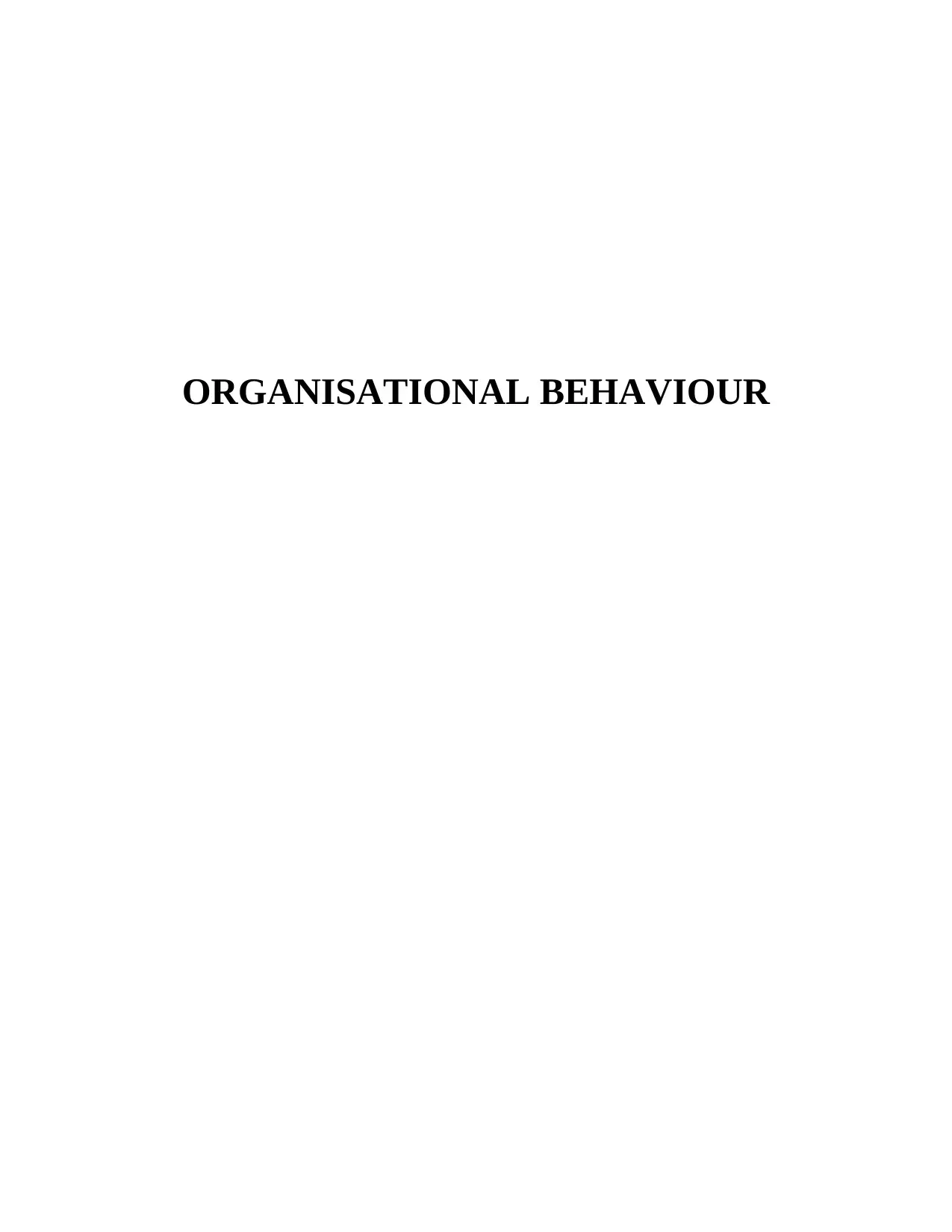
ORGANISATIONAL BEHAVIOUR
Secure Best Marks with AI Grader
Need help grading? Try our AI Grader for instant feedback on your assignments.
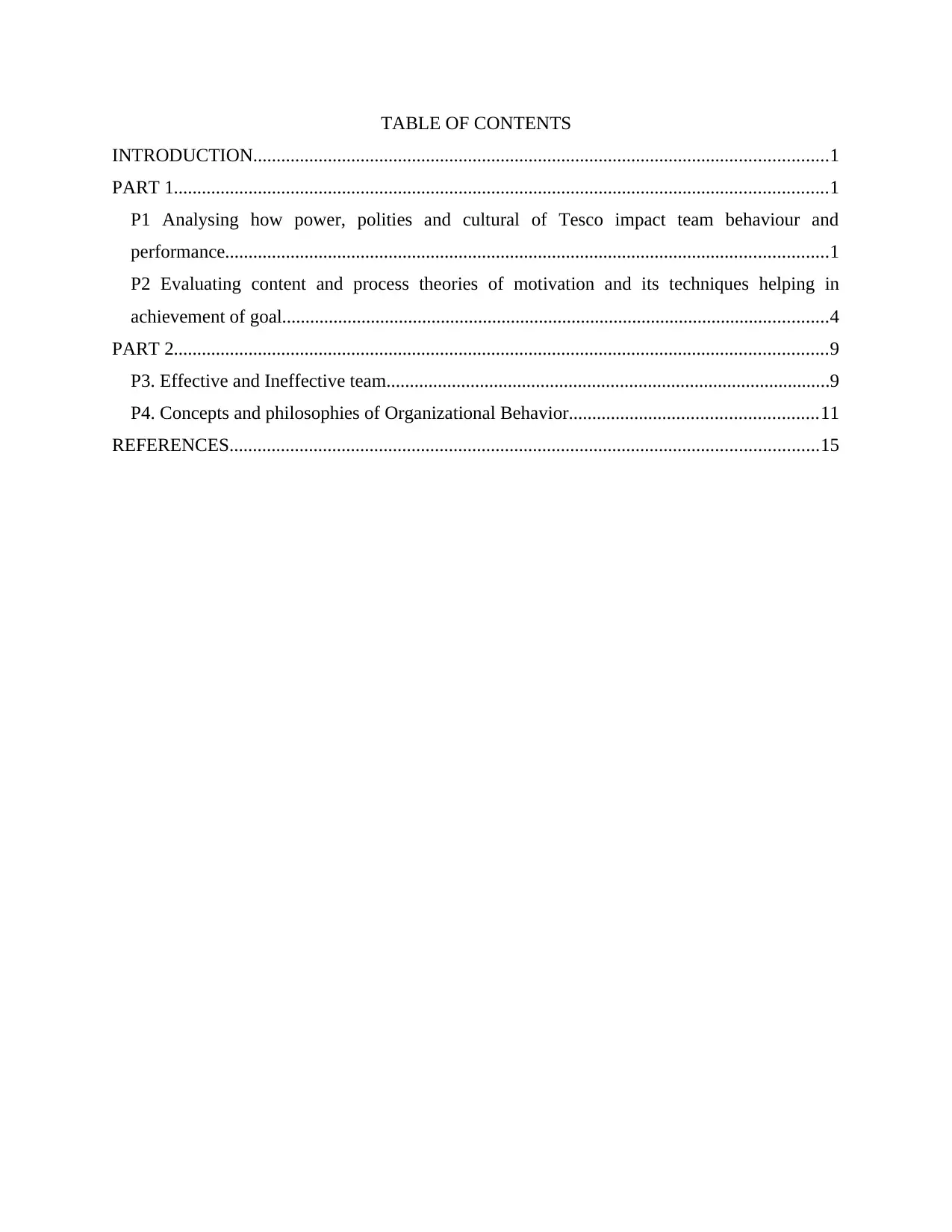
TABLE OF CONTENTS
INTRODUCTION...........................................................................................................................1
PART 1............................................................................................................................................1
P1 Analysing how power, polities and cultural of Tesco impact team behaviour and
performance.................................................................................................................................1
P2 Evaluating content and process theories of motivation and its techniques helping in
achievement of goal.....................................................................................................................4
PART 2............................................................................................................................................9
P3. Effective and Ineffective team...............................................................................................9
P4. Concepts and philosophies of Organizational Behavior.....................................................11
REFERENCES..............................................................................................................................15
INTRODUCTION...........................................................................................................................1
PART 1............................................................................................................................................1
P1 Analysing how power, polities and cultural of Tesco impact team behaviour and
performance.................................................................................................................................1
P2 Evaluating content and process theories of motivation and its techniques helping in
achievement of goal.....................................................................................................................4
PART 2............................................................................................................................................9
P3. Effective and Ineffective team...............................................................................................9
P4. Concepts and philosophies of Organizational Behavior.....................................................11
REFERENCES..............................................................................................................................15
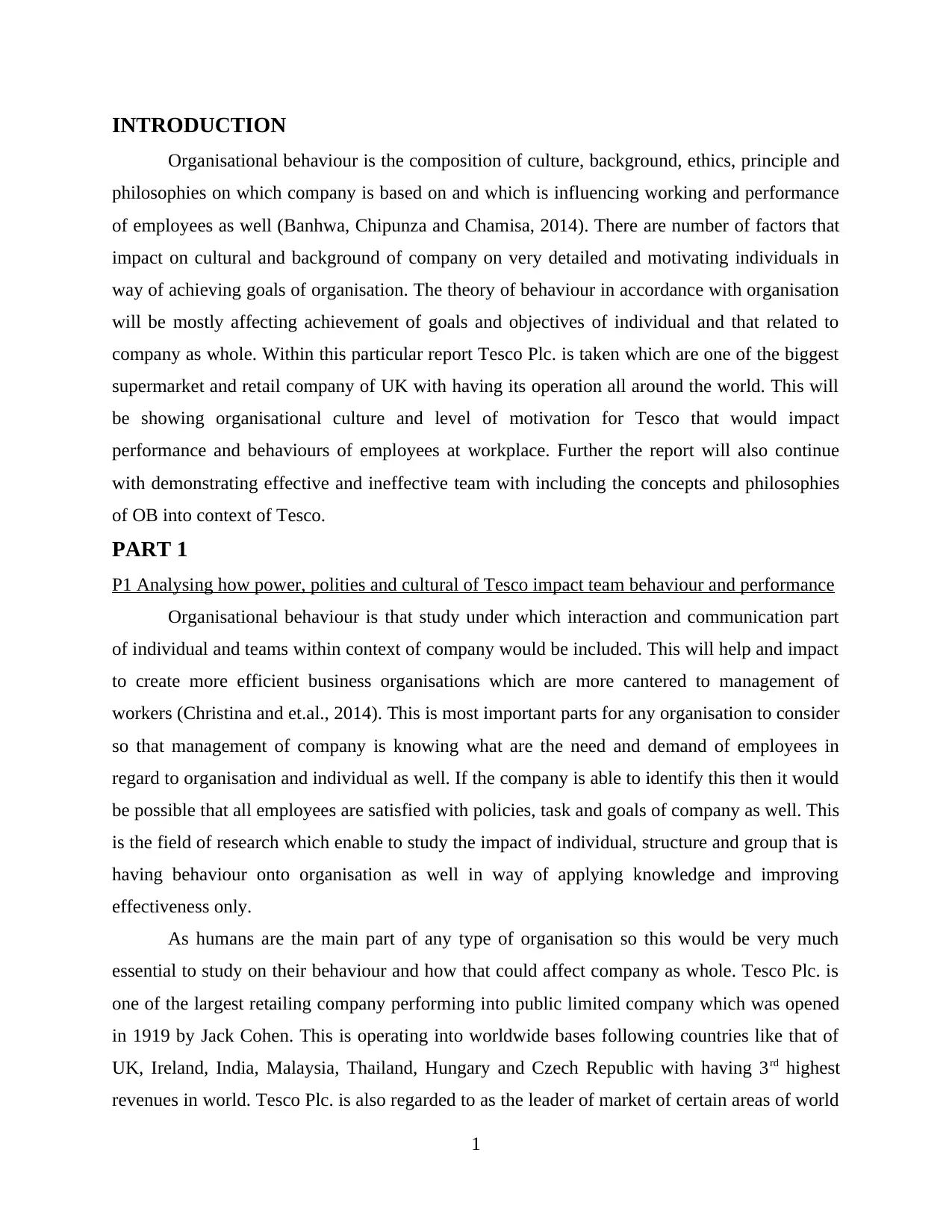
INTRODUCTION
Organisational behaviour is the composition of culture, background, ethics, principle and
philosophies on which company is based on and which is influencing working and performance
of employees as well (Banhwa, Chipunza and Chamisa, 2014). There are number of factors that
impact on cultural and background of company on very detailed and motivating individuals in
way of achieving goals of organisation. The theory of behaviour in accordance with organisation
will be mostly affecting achievement of goals and objectives of individual and that related to
company as whole. Within this particular report Tesco Plc. is taken which are one of the biggest
supermarket and retail company of UK with having its operation all around the world. This will
be showing organisational culture and level of motivation for Tesco that would impact
performance and behaviours of employees at workplace. Further the report will also continue
with demonstrating effective and ineffective team with including the concepts and philosophies
of OB into context of Tesco.
PART 1
P1 Analysing how power, polities and cultural of Tesco impact team behaviour and performance
Organisational behaviour is that study under which interaction and communication part
of individual and teams within context of company would be included. This will help and impact
to create more efficient business organisations which are more cantered to management of
workers (Christina and et.al., 2014). This is most important parts for any organisation to consider
so that management of company is knowing what are the need and demand of employees in
regard to organisation and individual as well. If the company is able to identify this then it would
be possible that all employees are satisfied with policies, task and goals of company as well. This
is the field of research which enable to study the impact of individual, structure and group that is
having behaviour onto organisation as well in way of applying knowledge and improving
effectiveness only.
As humans are the main part of any type of organisation so this would be very much
essential to study on their behaviour and how that could affect company as whole. Tesco Plc. is
one of the largest retailing company performing into public limited company which was opened
in 1919 by Jack Cohen. This is operating into worldwide bases following countries like that of
UK, Ireland, India, Malaysia, Thailand, Hungary and Czech Republic with having 3rd highest
revenues in world. Tesco Plc. is also regarded to as the leader of market of certain areas of world
1
Organisational behaviour is the composition of culture, background, ethics, principle and
philosophies on which company is based on and which is influencing working and performance
of employees as well (Banhwa, Chipunza and Chamisa, 2014). There are number of factors that
impact on cultural and background of company on very detailed and motivating individuals in
way of achieving goals of organisation. The theory of behaviour in accordance with organisation
will be mostly affecting achievement of goals and objectives of individual and that related to
company as whole. Within this particular report Tesco Plc. is taken which are one of the biggest
supermarket and retail company of UK with having its operation all around the world. This will
be showing organisational culture and level of motivation for Tesco that would impact
performance and behaviours of employees at workplace. Further the report will also continue
with demonstrating effective and ineffective team with including the concepts and philosophies
of OB into context of Tesco.
PART 1
P1 Analysing how power, polities and cultural of Tesco impact team behaviour and performance
Organisational behaviour is that study under which interaction and communication part
of individual and teams within context of company would be included. This will help and impact
to create more efficient business organisations which are more cantered to management of
workers (Christina and et.al., 2014). This is most important parts for any organisation to consider
so that management of company is knowing what are the need and demand of employees in
regard to organisation and individual as well. If the company is able to identify this then it would
be possible that all employees are satisfied with policies, task and goals of company as well. This
is the field of research which enable to study the impact of individual, structure and group that is
having behaviour onto organisation as well in way of applying knowledge and improving
effectiveness only.
As humans are the main part of any type of organisation so this would be very much
essential to study on their behaviour and how that could affect company as whole. Tesco Plc. is
one of the largest retailing company performing into public limited company which was opened
in 1919 by Jack Cohen. This is operating into worldwide bases following countries like that of
UK, Ireland, India, Malaysia, Thailand, Hungary and Czech Republic with having 3rd highest
revenues in world. Tesco Plc. is also regarded to as the leader of market of certain areas of world
1
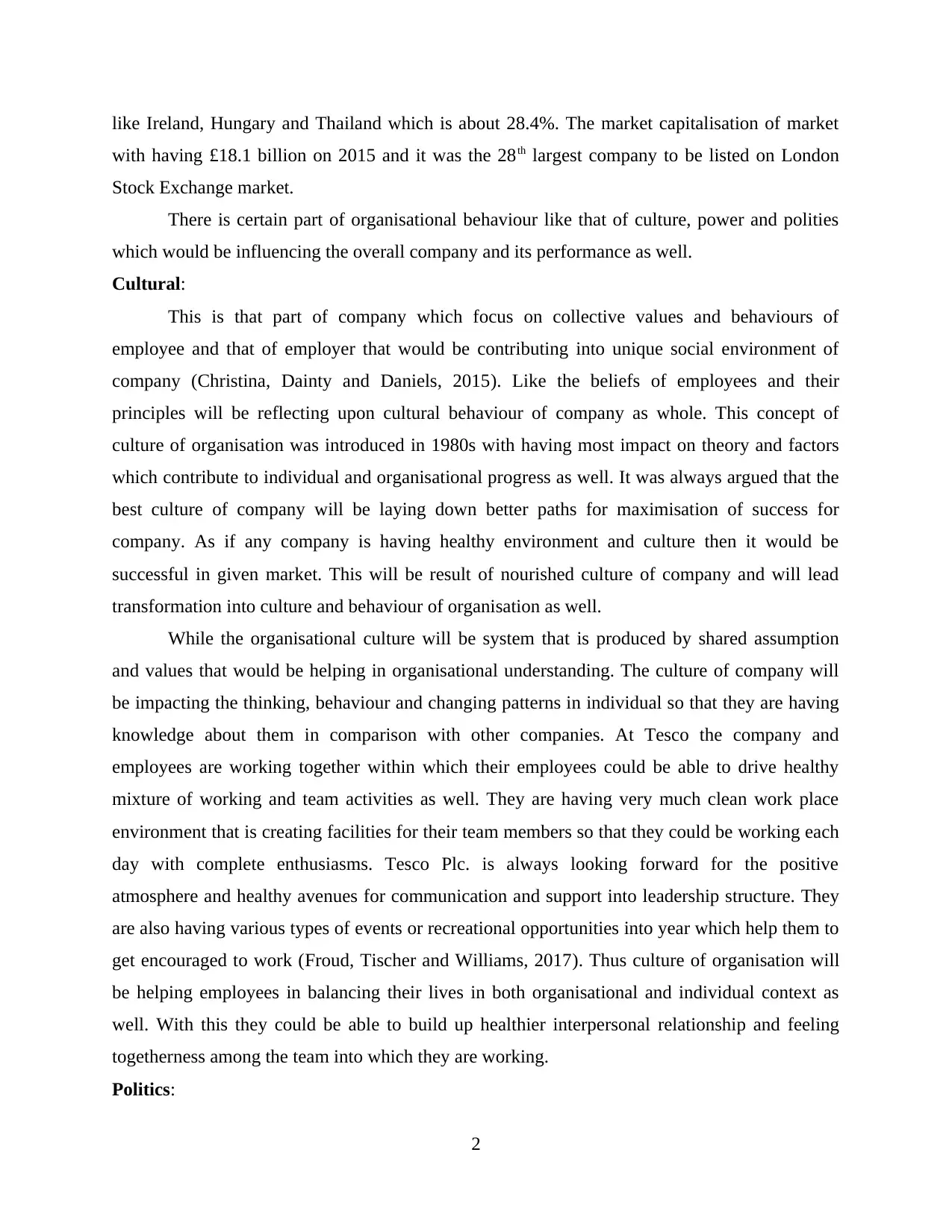
like Ireland, Hungary and Thailand which is about 28.4%. The market capitalisation of market
with having £18.1 billion on 2015 and it was the 28th largest company to be listed on London
Stock Exchange market.
There is certain part of organisational behaviour like that of culture, power and polities
which would be influencing the overall company and its performance as well.
Cultural:
This is that part of company which focus on collective values and behaviours of
employee and that of employer that would be contributing into unique social environment of
company (Christina, Dainty and Daniels, 2015). Like the beliefs of employees and their
principles will be reflecting upon cultural behaviour of company as whole. This concept of
culture of organisation was introduced in 1980s with having most impact on theory and factors
which contribute to individual and organisational progress as well. It was always argued that the
best culture of company will be laying down better paths for maximisation of success for
company. As if any company is having healthy environment and culture then it would be
successful in given market. This will be result of nourished culture of company and will lead
transformation into culture and behaviour of organisation as well.
While the organisational culture will be system that is produced by shared assumption
and values that would be helping in organisational understanding. The culture of company will
be impacting the thinking, behaviour and changing patterns in individual so that they are having
knowledge about them in comparison with other companies. At Tesco the company and
employees are working together within which their employees could be able to drive healthy
mixture of working and team activities as well. They are having very much clean work place
environment that is creating facilities for their team members so that they could be working each
day with complete enthusiasms. Tesco Plc. is always looking forward for the positive
atmosphere and healthy avenues for communication and support into leadership structure. They
are also having various types of events or recreational opportunities into year which help them to
get encouraged to work (Froud, Tischer and Williams, 2017). Thus culture of organisation will
be helping employees in balancing their lives in both organisational and individual context as
well. With this they could be able to build up healthier interpersonal relationship and feeling
togetherness among the team into which they are working.
Politics:
2
with having £18.1 billion on 2015 and it was the 28th largest company to be listed on London
Stock Exchange market.
There is certain part of organisational behaviour like that of culture, power and polities
which would be influencing the overall company and its performance as well.
Cultural:
This is that part of company which focus on collective values and behaviours of
employee and that of employer that would be contributing into unique social environment of
company (Christina, Dainty and Daniels, 2015). Like the beliefs of employees and their
principles will be reflecting upon cultural behaviour of company as whole. This concept of
culture of organisation was introduced in 1980s with having most impact on theory and factors
which contribute to individual and organisational progress as well. It was always argued that the
best culture of company will be laying down better paths for maximisation of success for
company. As if any company is having healthy environment and culture then it would be
successful in given market. This will be result of nourished culture of company and will lead
transformation into culture and behaviour of organisation as well.
While the organisational culture will be system that is produced by shared assumption
and values that would be helping in organisational understanding. The culture of company will
be impacting the thinking, behaviour and changing patterns in individual so that they are having
knowledge about them in comparison with other companies. At Tesco the company and
employees are working together within which their employees could be able to drive healthy
mixture of working and team activities as well. They are having very much clean work place
environment that is creating facilities for their team members so that they could be working each
day with complete enthusiasms. Tesco Plc. is always looking forward for the positive
atmosphere and healthy avenues for communication and support into leadership structure. They
are also having various types of events or recreational opportunities into year which help them to
get encouraged to work (Froud, Tischer and Williams, 2017). Thus culture of organisation will
be helping employees in balancing their lives in both organisational and individual context as
well. With this they could be able to build up healthier interpersonal relationship and feeling
togetherness among the team into which they are working.
Politics:
2
Secure Best Marks with AI Grader
Need help grading? Try our AI Grader for instant feedback on your assignments.
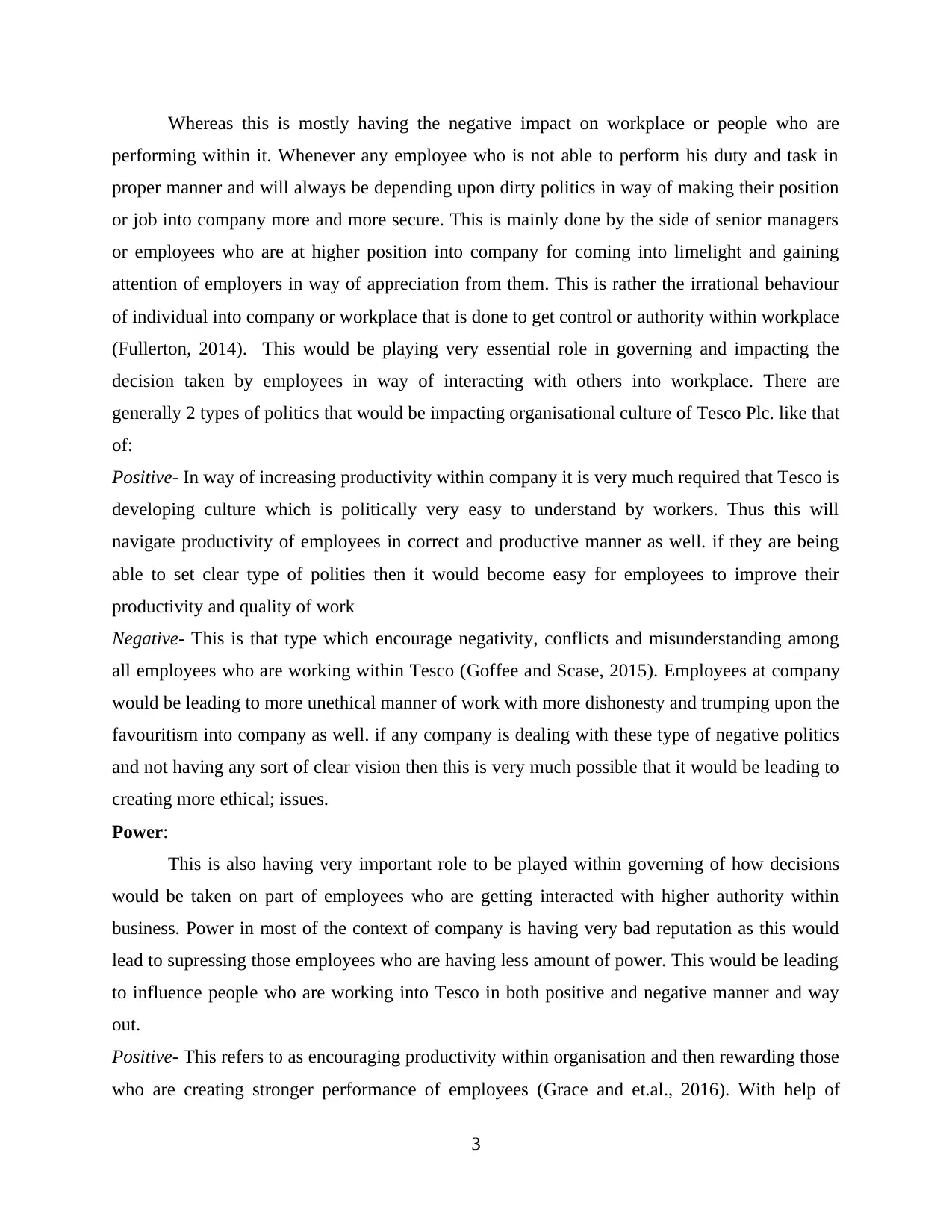
Whereas this is mostly having the negative impact on workplace or people who are
performing within it. Whenever any employee who is not able to perform his duty and task in
proper manner and will always be depending upon dirty politics in way of making their position
or job into company more and more secure. This is mainly done by the side of senior managers
or employees who are at higher position into company for coming into limelight and gaining
attention of employers in way of appreciation from them. This is rather the irrational behaviour
of individual into company or workplace that is done to get control or authority within workplace
(Fullerton, 2014). This would be playing very essential role in governing and impacting the
decision taken by employees in way of interacting with others into workplace. There are
generally 2 types of politics that would be impacting organisational culture of Tesco Plc. like that
of:
Positive- In way of increasing productivity within company it is very much required that Tesco is
developing culture which is politically very easy to understand by workers. Thus this will
navigate productivity of employees in correct and productive manner as well. if they are being
able to set clear type of polities then it would become easy for employees to improve their
productivity and quality of work
Negative- This is that type which encourage negativity, conflicts and misunderstanding among
all employees who are working within Tesco (Goffee and Scase, 2015). Employees at company
would be leading to more unethical manner of work with more dishonesty and trumping upon the
favouritism into company as well. if any company is dealing with these type of negative politics
and not having any sort of clear vision then this is very much possible that it would be leading to
creating more ethical; issues.
Power:
This is also having very important role to be played within governing of how decisions
would be taken on part of employees who are getting interacted with higher authority within
business. Power in most of the context of company is having very bad reputation as this would
lead to supressing those employees who are having less amount of power. This would be leading
to influence people who are working into Tesco in both positive and negative manner and way
out.
Positive- This refers to as encouraging productivity within organisation and then rewarding those
who are creating stronger performance of employees (Grace and et.al., 2016). With help of
3
performing within it. Whenever any employee who is not able to perform his duty and task in
proper manner and will always be depending upon dirty politics in way of making their position
or job into company more and more secure. This is mainly done by the side of senior managers
or employees who are at higher position into company for coming into limelight and gaining
attention of employers in way of appreciation from them. This is rather the irrational behaviour
of individual into company or workplace that is done to get control or authority within workplace
(Fullerton, 2014). This would be playing very essential role in governing and impacting the
decision taken by employees in way of interacting with others into workplace. There are
generally 2 types of politics that would be impacting organisational culture of Tesco Plc. like that
of:
Positive- In way of increasing productivity within company it is very much required that Tesco is
developing culture which is politically very easy to understand by workers. Thus this will
navigate productivity of employees in correct and productive manner as well. if they are being
able to set clear type of polities then it would become easy for employees to improve their
productivity and quality of work
Negative- This is that type which encourage negativity, conflicts and misunderstanding among
all employees who are working within Tesco (Goffee and Scase, 2015). Employees at company
would be leading to more unethical manner of work with more dishonesty and trumping upon the
favouritism into company as well. if any company is dealing with these type of negative politics
and not having any sort of clear vision then this is very much possible that it would be leading to
creating more ethical; issues.
Power:
This is also having very important role to be played within governing of how decisions
would be taken on part of employees who are getting interacted with higher authority within
business. Power in most of the context of company is having very bad reputation as this would
lead to supressing those employees who are having less amount of power. This would be leading
to influence people who are working into Tesco in both positive and negative manner and way
out.
Positive- This refers to as encouraging productivity within organisation and then rewarding those
who are creating stronger performance of employees (Grace and et.al., 2016). With help of
3
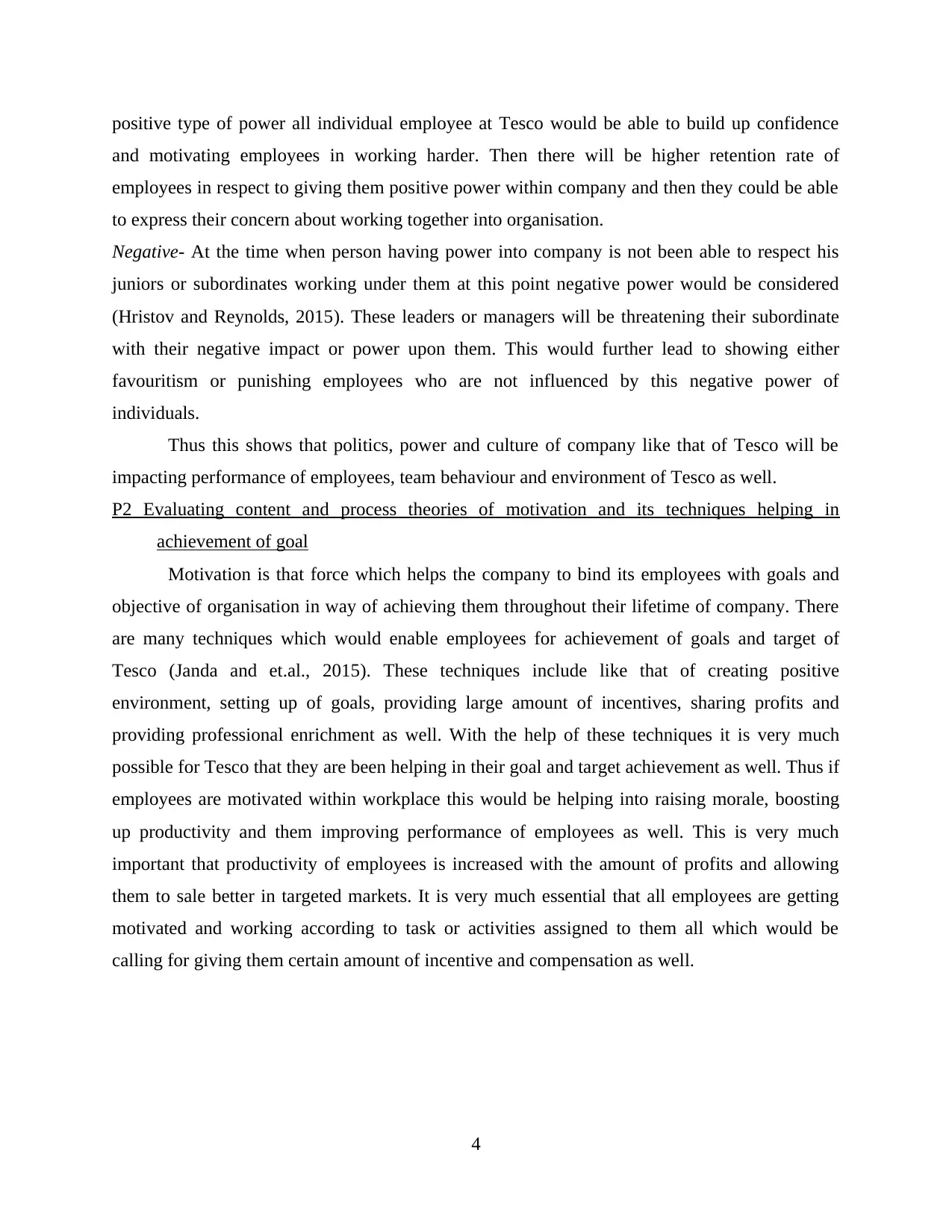
positive type of power all individual employee at Tesco would be able to build up confidence
and motivating employees in working harder. Then there will be higher retention rate of
employees in respect to giving them positive power within company and then they could be able
to express their concern about working together into organisation.
Negative- At the time when person having power into company is not been able to respect his
juniors or subordinates working under them at this point negative power would be considered
(Hristov and Reynolds, 2015). These leaders or managers will be threatening their subordinate
with their negative impact or power upon them. This would further lead to showing either
favouritism or punishing employees who are not influenced by this negative power of
individuals.
Thus this shows that politics, power and culture of company like that of Tesco will be
impacting performance of employees, team behaviour and environment of Tesco as well.
P2 Evaluating content and process theories of motivation and its techniques helping in
achievement of goal
Motivation is that force which helps the company to bind its employees with goals and
objective of organisation in way of achieving them throughout their lifetime of company. There
are many techniques which would enable employees for achievement of goals and target of
Tesco (Janda and et.al., 2015). These techniques include like that of creating positive
environment, setting up of goals, providing large amount of incentives, sharing profits and
providing professional enrichment as well. With the help of these techniques it is very much
possible for Tesco that they are been helping in their goal and target achievement as well. Thus if
employees are motivated within workplace this would be helping into raising morale, boosting
up productivity and them improving performance of employees as well. This is very much
important that productivity of employees is increased with the amount of profits and allowing
them to sale better in targeted markets. It is very much essential that all employees are getting
motivated and working according to task or activities assigned to them all which would be
calling for giving them certain amount of incentive and compensation as well.
4
and motivating employees in working harder. Then there will be higher retention rate of
employees in respect to giving them positive power within company and then they could be able
to express their concern about working together into organisation.
Negative- At the time when person having power into company is not been able to respect his
juniors or subordinates working under them at this point negative power would be considered
(Hristov and Reynolds, 2015). These leaders or managers will be threatening their subordinate
with their negative impact or power upon them. This would further lead to showing either
favouritism or punishing employees who are not influenced by this negative power of
individuals.
Thus this shows that politics, power and culture of company like that of Tesco will be
impacting performance of employees, team behaviour and environment of Tesco as well.
P2 Evaluating content and process theories of motivation and its techniques helping in
achievement of goal
Motivation is that force which helps the company to bind its employees with goals and
objective of organisation in way of achieving them throughout their lifetime of company. There
are many techniques which would enable employees for achievement of goals and target of
Tesco (Janda and et.al., 2015). These techniques include like that of creating positive
environment, setting up of goals, providing large amount of incentives, sharing profits and
providing professional enrichment as well. With the help of these techniques it is very much
possible for Tesco that they are been helping in their goal and target achievement as well. Thus if
employees are motivated within workplace this would be helping into raising morale, boosting
up productivity and them improving performance of employees as well. This is very much
important that productivity of employees is increased with the amount of profits and allowing
them to sale better in targeted markets. It is very much essential that all employees are getting
motivated and working according to task or activities assigned to them all which would be
calling for giving them certain amount of incentive and compensation as well.
4
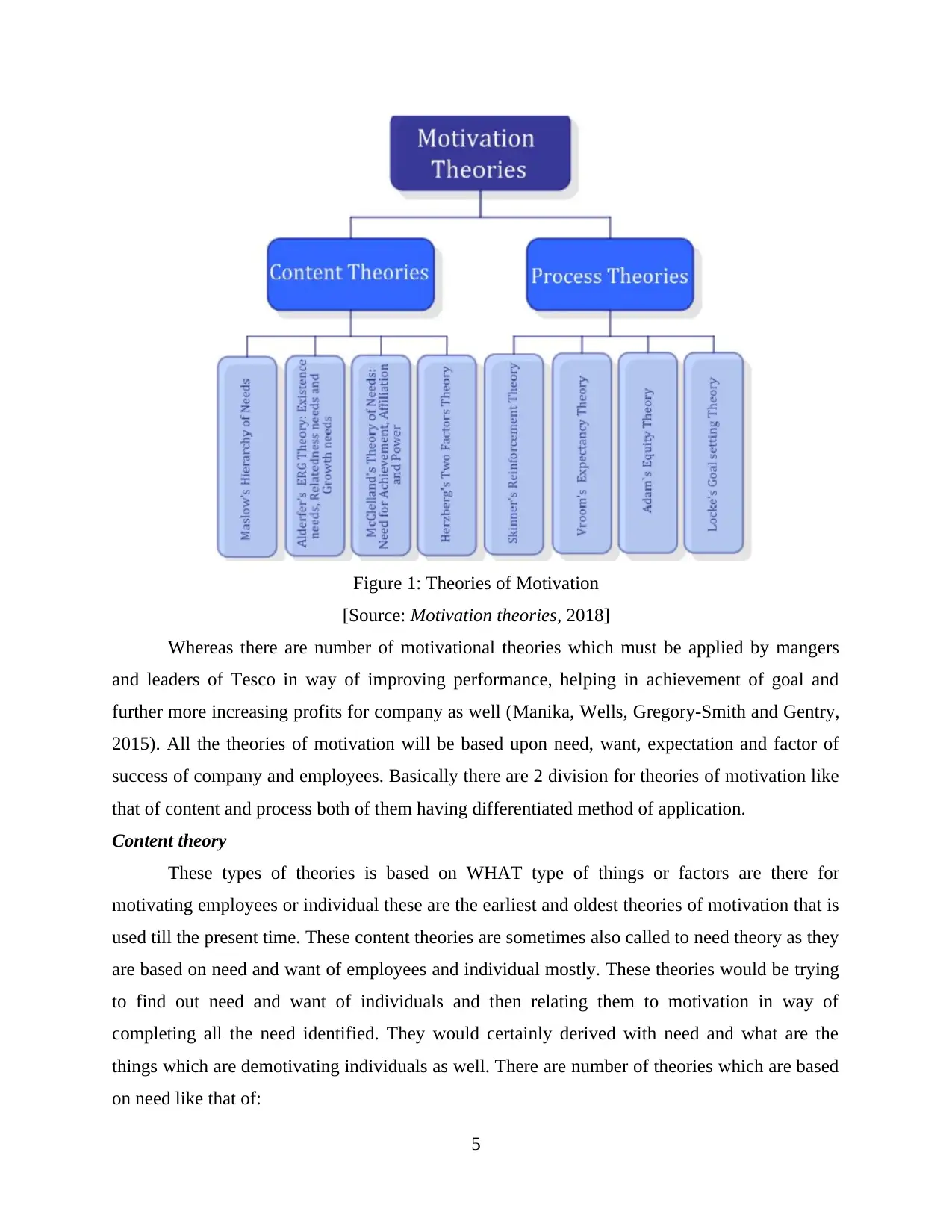
Figure 1: Theories of Motivation
[Source: Motivation theories, 2018]
Whereas there are number of motivational theories which must be applied by mangers
and leaders of Tesco in way of improving performance, helping in achievement of goal and
further more increasing profits for company as well (Manika, Wells, Gregory-Smith and Gentry,
2015). All the theories of motivation will be based upon need, want, expectation and factor of
success of company and employees. Basically there are 2 division for theories of motivation like
that of content and process both of them having differentiated method of application.
Content theory
These types of theories is based on WHAT type of things or factors are there for
motivating employees or individual these are the earliest and oldest theories of motivation that is
used till the present time. These content theories are sometimes also called to need theory as they
are based on need and want of employees and individual mostly. These theories would be trying
to find out need and want of individuals and then relating them to motivation in way of
completing all the need identified. They would certainly derived with need and what are the
things which are demotivating individuals as well. There are number of theories which are based
on need like that of:
5
[Source: Motivation theories, 2018]
Whereas there are number of motivational theories which must be applied by mangers
and leaders of Tesco in way of improving performance, helping in achievement of goal and
further more increasing profits for company as well (Manika, Wells, Gregory-Smith and Gentry,
2015). All the theories of motivation will be based upon need, want, expectation and factor of
success of company and employees. Basically there are 2 division for theories of motivation like
that of content and process both of them having differentiated method of application.
Content theory
These types of theories is based on WHAT type of things or factors are there for
motivating employees or individual these are the earliest and oldest theories of motivation that is
used till the present time. These content theories are sometimes also called to need theory as they
are based on need and want of employees and individual mostly. These theories would be trying
to find out need and want of individuals and then relating them to motivation in way of
completing all the need identified. They would certainly derived with need and what are the
things which are demotivating individuals as well. There are number of theories which are based
on need like that of:
5
Paraphrase This Document
Need a fresh take? Get an instant paraphrase of this document with our AI Paraphraser
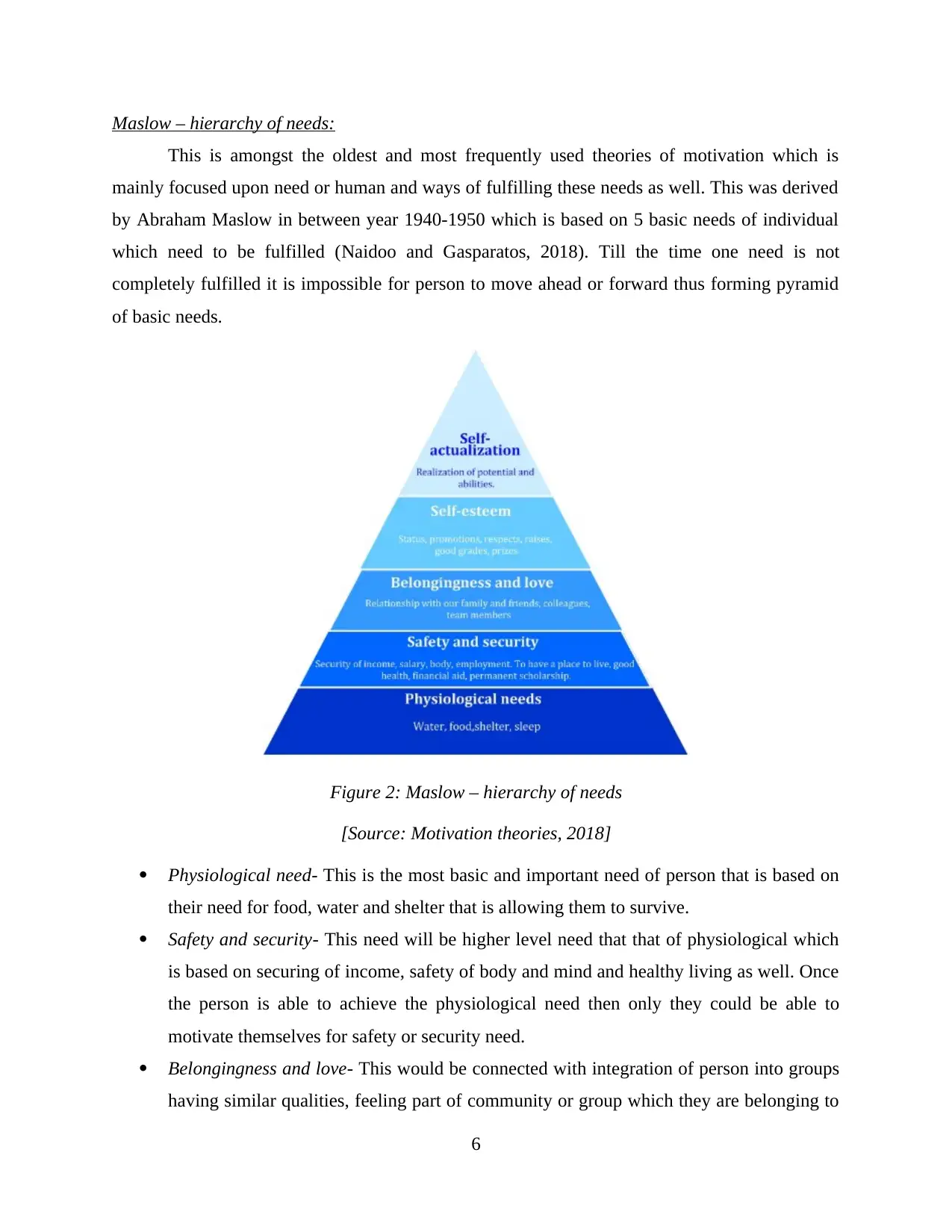
Maslow – hierarchy of needs:
This is amongst the oldest and most frequently used theories of motivation which is
mainly focused upon need or human and ways of fulfilling these needs as well. This was derived
by Abraham Maslow in between year 1940-1950 which is based on 5 basic needs of individual
which need to be fulfilled (Naidoo and Gasparatos, 2018). Till the time one need is not
completely fulfilled it is impossible for person to move ahead or forward thus forming pyramid
of basic needs.
Figure 2: Maslow – hierarchy of needs
[Source: Motivation theories, 2018]
Physiological need- This is the most basic and important need of person that is based on
their need for food, water and shelter that is allowing them to survive.
Safety and security- This need will be higher level need that that of physiological which
is based on securing of income, safety of body and mind and healthy living as well. Once
the person is able to achieve the physiological need then only they could be able to
motivate themselves for safety or security need.
Belongingness and love- This would be connected with integration of person into groups
having similar qualities, feeling part of community or group which they are belonging to
6
This is amongst the oldest and most frequently used theories of motivation which is
mainly focused upon need or human and ways of fulfilling these needs as well. This was derived
by Abraham Maslow in between year 1940-1950 which is based on 5 basic needs of individual
which need to be fulfilled (Naidoo and Gasparatos, 2018). Till the time one need is not
completely fulfilled it is impossible for person to move ahead or forward thus forming pyramid
of basic needs.
Figure 2: Maslow – hierarchy of needs
[Source: Motivation theories, 2018]
Physiological need- This is the most basic and important need of person that is based on
their need for food, water and shelter that is allowing them to survive.
Safety and security- This need will be higher level need that that of physiological which
is based on securing of income, safety of body and mind and healthy living as well. Once
the person is able to achieve the physiological need then only they could be able to
motivate themselves for safety or security need.
Belongingness and love- This would be connected with integration of person into groups
having similar qualities, feeling part of community or group which they are belonging to
6
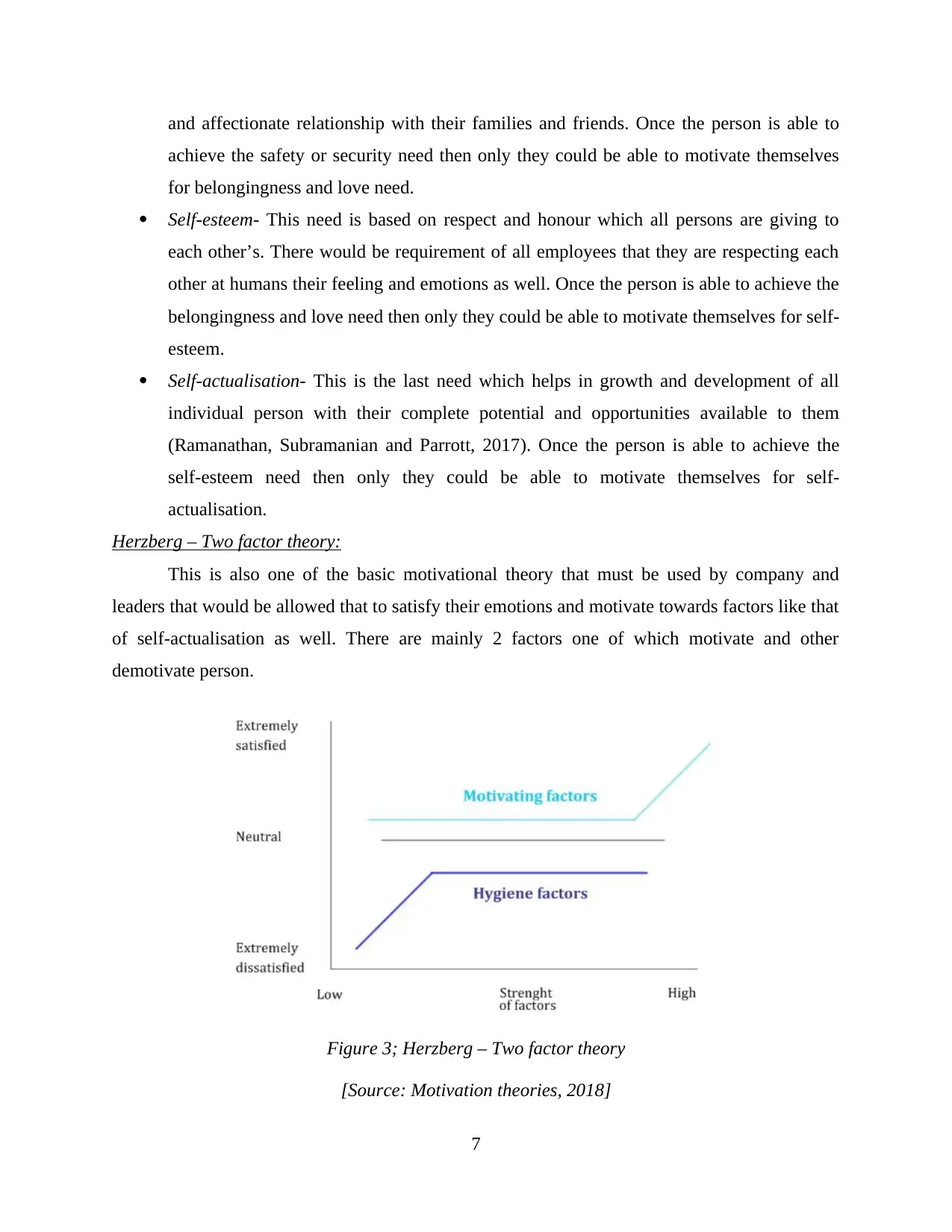
and affectionate relationship with their families and friends. Once the person is able to
achieve the safety or security need then only they could be able to motivate themselves
for belongingness and love need.
Self-esteem- This need is based on respect and honour which all persons are giving to
each other’s. There would be requirement of all employees that they are respecting each
other at humans their feeling and emotions as well. Once the person is able to achieve the
belongingness and love need then only they could be able to motivate themselves for self-
esteem.
Self-actualisation- This is the last need which helps in growth and development of all
individual person with their complete potential and opportunities available to them
(Ramanathan, Subramanian and Parrott, 2017). Once the person is able to achieve the
self-esteem need then only they could be able to motivate themselves for self-
actualisation.
Herzberg – Two factor theory:
This is also one of the basic motivational theory that must be used by company and
leaders that would be allowed that to satisfy their emotions and motivate towards factors like that
of self-actualisation as well. There are mainly 2 factors one of which motivate and other
demotivate person.
Figure 3; Herzberg – Two factor theory
[Source: Motivation theories, 2018]
7
achieve the safety or security need then only they could be able to motivate themselves
for belongingness and love need.
Self-esteem- This need is based on respect and honour which all persons are giving to
each other’s. There would be requirement of all employees that they are respecting each
other at humans their feeling and emotions as well. Once the person is able to achieve the
belongingness and love need then only they could be able to motivate themselves for self-
esteem.
Self-actualisation- This is the last need which helps in growth and development of all
individual person with their complete potential and opportunities available to them
(Ramanathan, Subramanian and Parrott, 2017). Once the person is able to achieve the
self-esteem need then only they could be able to motivate themselves for self-
actualisation.
Herzberg – Two factor theory:
This is also one of the basic motivational theory that must be used by company and
leaders that would be allowed that to satisfy their emotions and motivate towards factors like that
of self-actualisation as well. There are mainly 2 factors one of which motivate and other
demotivate person.
Figure 3; Herzberg – Two factor theory
[Source: Motivation theories, 2018]
7
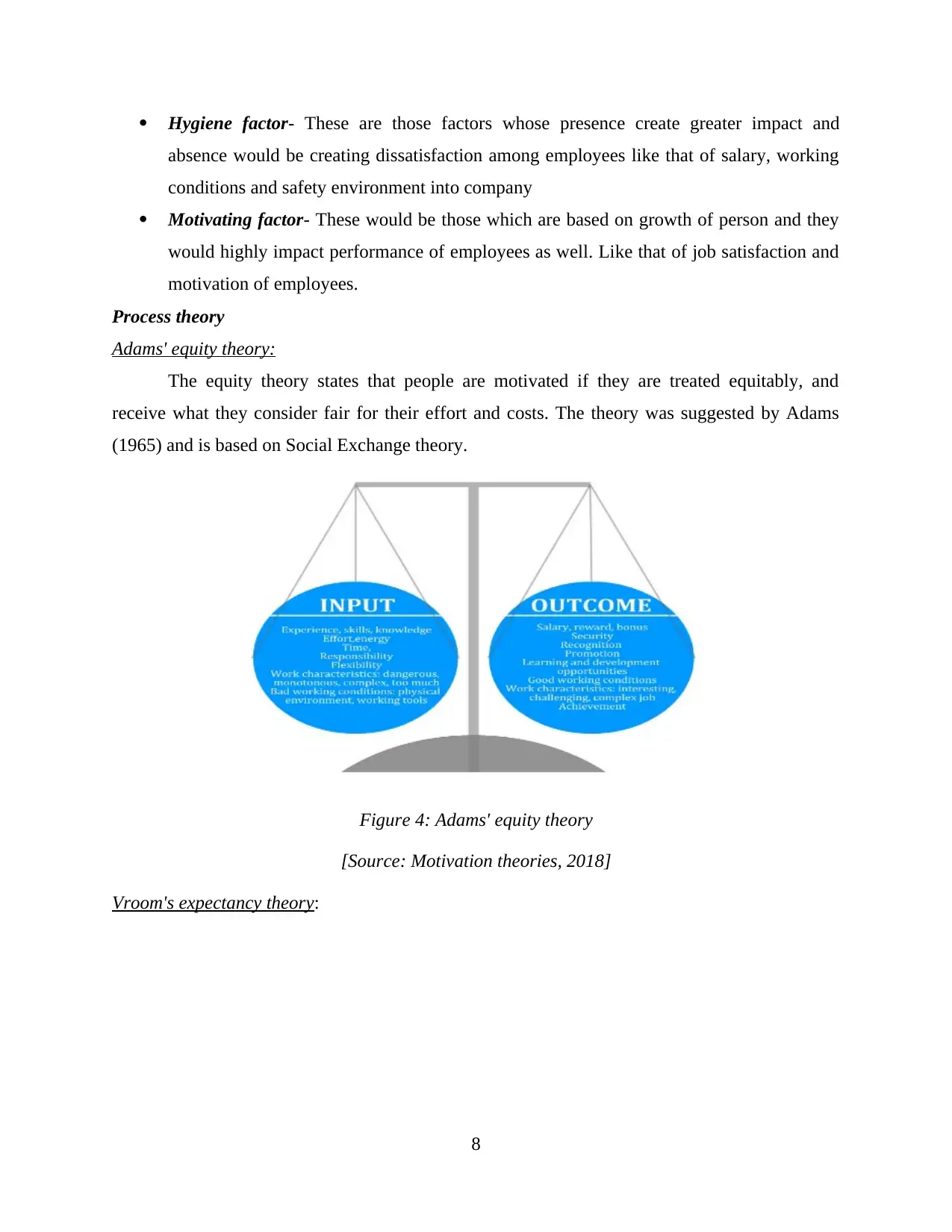
Hygiene factor- These are those factors whose presence create greater impact and
absence would be creating dissatisfaction among employees like that of salary, working
conditions and safety environment into company
Motivating factor- These would be those which are based on growth of person and they
would highly impact performance of employees as well. Like that of job satisfaction and
motivation of employees.
Process theory
Adams' equity theory:
The equity theory states that people are motivated if they are treated equitably, and
receive what they consider fair for their effort and costs. The theory was suggested by Adams
(1965) and is based on Social Exchange theory.
Figure 4: Adams' equity theory
[Source: Motivation theories, 2018]
Vroom's expectancy theory:
8
absence would be creating dissatisfaction among employees like that of salary, working
conditions and safety environment into company
Motivating factor- These would be those which are based on growth of person and they
would highly impact performance of employees as well. Like that of job satisfaction and
motivation of employees.
Process theory
Adams' equity theory:
The equity theory states that people are motivated if they are treated equitably, and
receive what they consider fair for their effort and costs. The theory was suggested by Adams
(1965) and is based on Social Exchange theory.
Figure 4: Adams' equity theory
[Source: Motivation theories, 2018]
Vroom's expectancy theory:
8
Secure Best Marks with AI Grader
Need help grading? Try our AI Grader for instant feedback on your assignments.
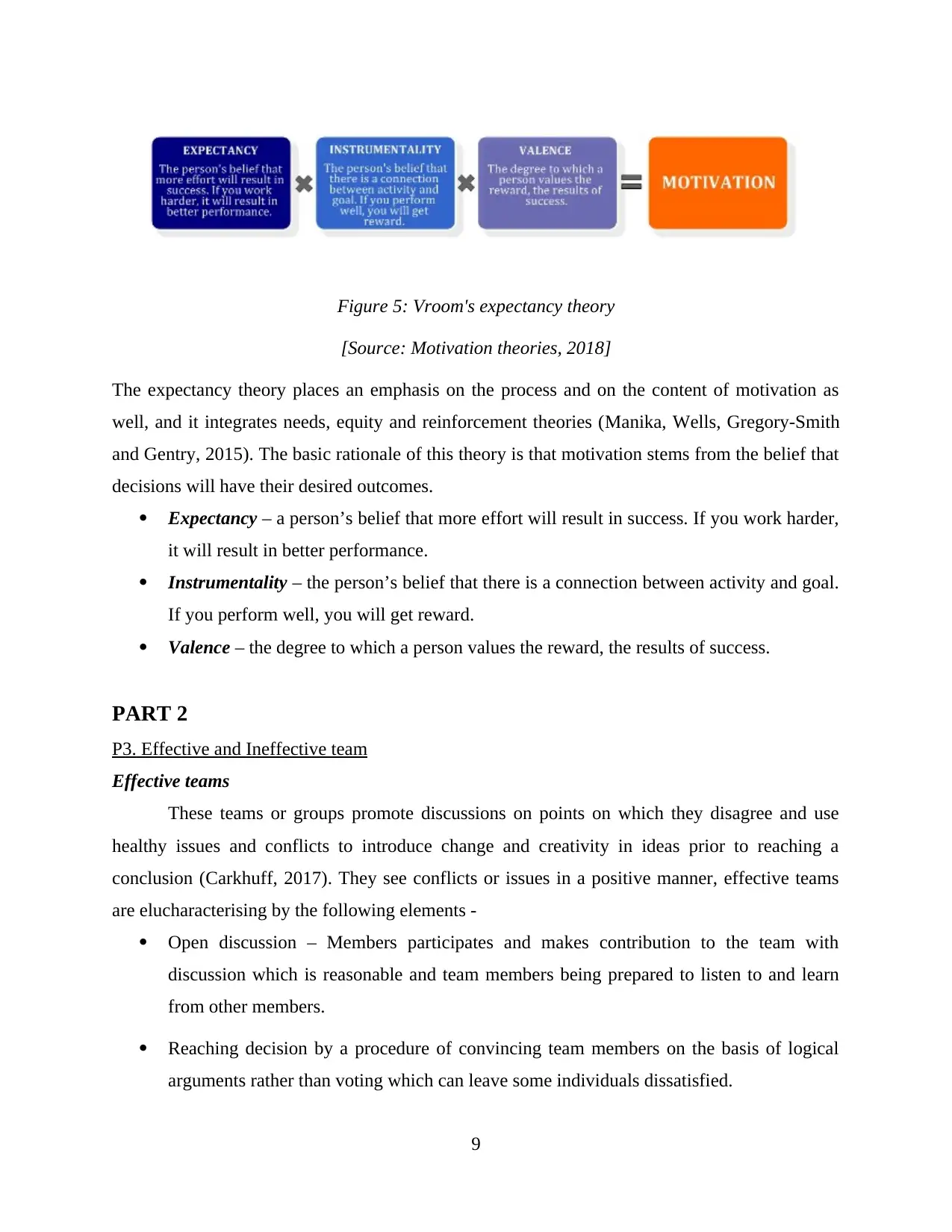
Figure 5: Vroom's expectancy theory
[Source: Motivation theories, 2018]
The expectancy theory places an emphasis on the process and on the content of motivation as
well, and it integrates needs, equity and reinforcement theories (Manika, Wells, Gregory-Smith
and Gentry, 2015). The basic rationale of this theory is that motivation stems from the belief that
decisions will have their desired outcomes.
Expectancy – a person’s belief that more effort will result in success. If you work harder,
it will result in better performance.
Instrumentality – the person’s belief that there is a connection between activity and goal.
If you perform well, you will get reward.
Valence – the degree to which a person values the reward, the results of success.
PART 2
P3. Effective and Ineffective team
Effective teams
These teams or groups promote discussions on points on which they disagree and use
healthy issues and conflicts to introduce change and creativity in ideas prior to reaching a
conclusion (Carkhuff, 2017). They see conflicts or issues in a positive manner, effective teams
are elucharacterising by the following elements -
Open discussion – Members participates and makes contribution to the team with
discussion which is reasonable and team members being prepared to listen to and learn
from other members.
Reaching decision by a procedure of convincing team members on the basis of logical
arguments rather than voting which can leave some individuals dissatisfied.
9
[Source: Motivation theories, 2018]
The expectancy theory places an emphasis on the process and on the content of motivation as
well, and it integrates needs, equity and reinforcement theories (Manika, Wells, Gregory-Smith
and Gentry, 2015). The basic rationale of this theory is that motivation stems from the belief that
decisions will have their desired outcomes.
Expectancy – a person’s belief that more effort will result in success. If you work harder,
it will result in better performance.
Instrumentality – the person’s belief that there is a connection between activity and goal.
If you perform well, you will get reward.
Valence – the degree to which a person values the reward, the results of success.
PART 2
P3. Effective and Ineffective team
Effective teams
These teams or groups promote discussions on points on which they disagree and use
healthy issues and conflicts to introduce change and creativity in ideas prior to reaching a
conclusion (Carkhuff, 2017). They see conflicts or issues in a positive manner, effective teams
are elucharacterising by the following elements -
Open discussion – Members participates and makes contribution to the team with
discussion which is reasonable and team members being prepared to listen to and learn
from other members.
Reaching decision by a procedure of convincing team members on the basis of logical
arguments rather than voting which can leave some individuals dissatisfied.
9
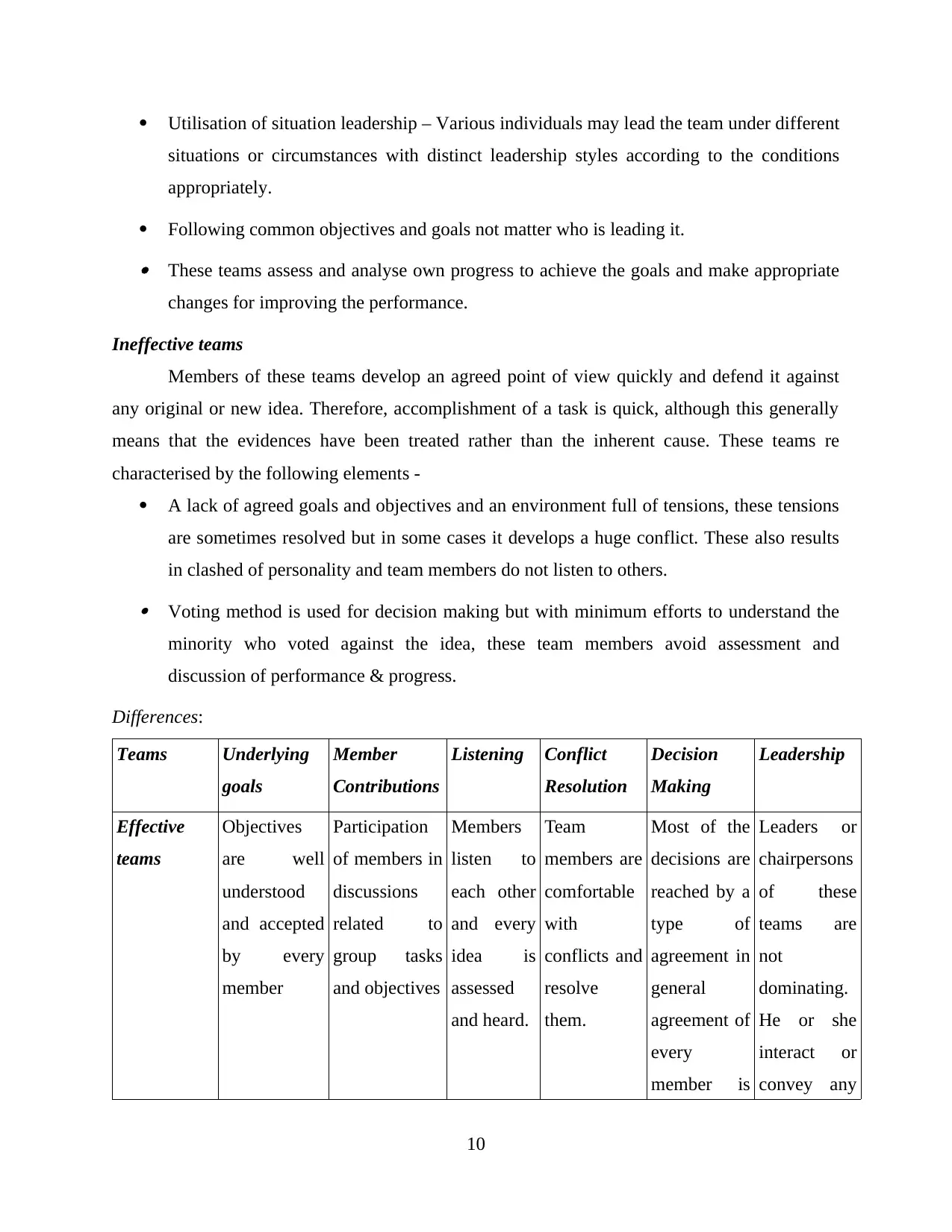
Utilisation of situation leadership – Various individuals may lead the team under different
situations or circumstances with distinct leadership styles according to the conditions
appropriately.
Following common objectives and goals not matter who is leading it. These teams assess and analyse own progress to achieve the goals and make appropriate
changes for improving the performance.
Ineffective teams
Members of these teams develop an agreed point of view quickly and defend it against
any original or new idea. Therefore, accomplishment of a task is quick, although this generally
means that the evidences have been treated rather than the inherent cause. These teams re
characterised by the following elements -
A lack of agreed goals and objectives and an environment full of tensions, these tensions
are sometimes resolved but in some cases it develops a huge conflict. These also results
in clashed of personality and team members do not listen to others. Voting method is used for decision making but with minimum efforts to understand the
minority who voted against the idea, these team members avoid assessment and
discussion of performance & progress.
Differences:
Teams Underlying
goals
Member
Contributions
Listening Conflict
Resolution
Decision
Making
Leadership
Effective
teams
Objectives
are well
understood
and accepted
by every
member
Participation
of members in
discussions
related to
group tasks
and objectives
Members
listen to
each other
and every
idea is
assessed
and heard.
Team
members are
comfortable
with
conflicts and
resolve
them.
Most of the
decisions are
reached by a
type of
agreement in
general
agreement of
every
member is
Leaders or
chairpersons
of these
teams are
not
dominating.
He or she
interact or
convey any
10
situations or circumstances with distinct leadership styles according to the conditions
appropriately.
Following common objectives and goals not matter who is leading it. These teams assess and analyse own progress to achieve the goals and make appropriate
changes for improving the performance.
Ineffective teams
Members of these teams develop an agreed point of view quickly and defend it against
any original or new idea. Therefore, accomplishment of a task is quick, although this generally
means that the evidences have been treated rather than the inherent cause. These teams re
characterised by the following elements -
A lack of agreed goals and objectives and an environment full of tensions, these tensions
are sometimes resolved but in some cases it develops a huge conflict. These also results
in clashed of personality and team members do not listen to others. Voting method is used for decision making but with minimum efforts to understand the
minority who voted against the idea, these team members avoid assessment and
discussion of performance & progress.
Differences:
Teams Underlying
goals
Member
Contributions
Listening Conflict
Resolution
Decision
Making
Leadership
Effective
teams
Objectives
are well
understood
and accepted
by every
member
Participation
of members in
discussions
related to
group tasks
and objectives
Members
listen to
each other
and every
idea is
assessed
and heard.
Team
members are
comfortable
with
conflicts and
resolve
them.
Most of the
decisions are
reached by a
type of
agreement in
general
agreement of
every
member is
Leaders or
chairpersons
of these
teams are
not
dominating.
He or she
interact or
convey any
10
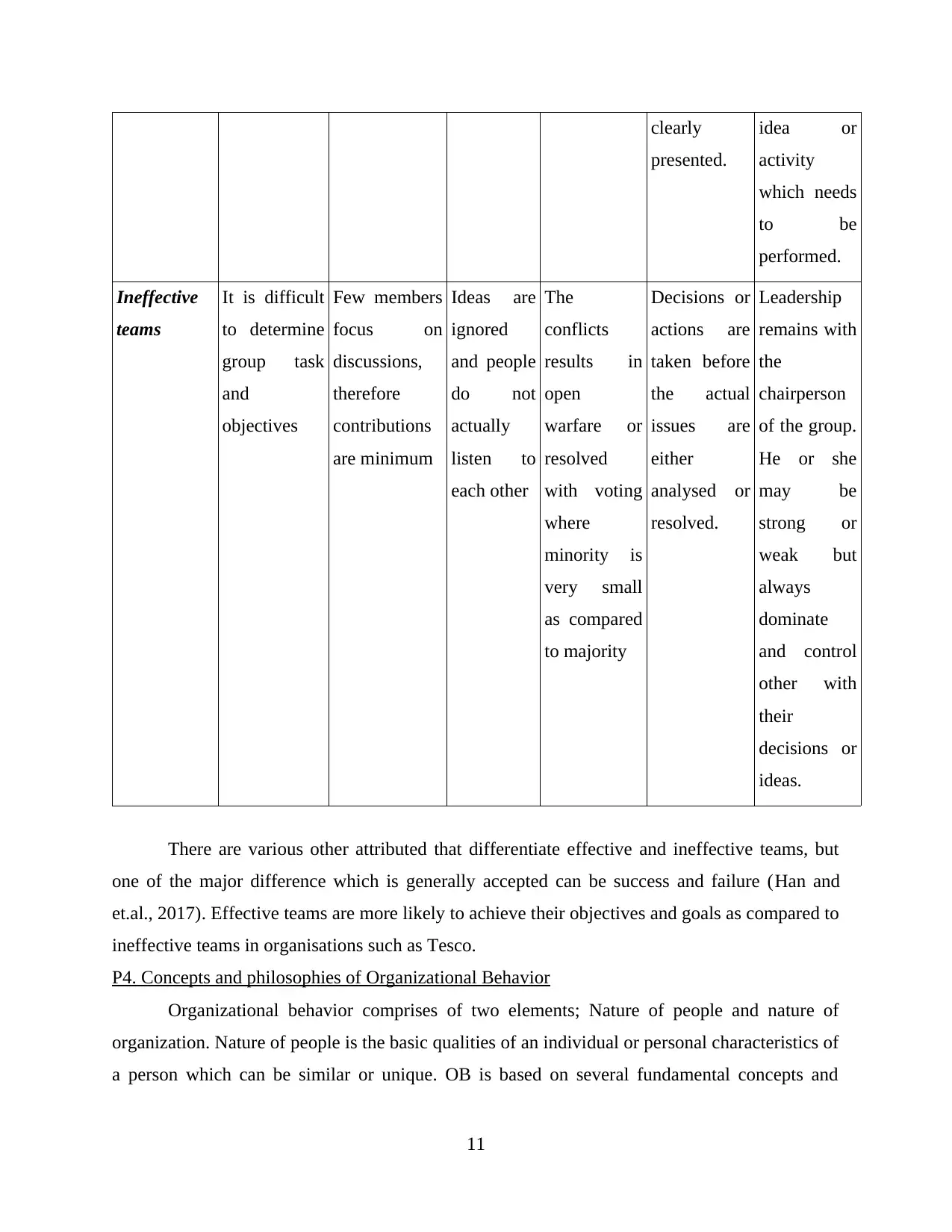
clearly
presented.
idea or
activity
which needs
to be
performed.
Ineffective
teams
It is difficult
to determine
group task
and
objectives
Few members
focus on
discussions,
therefore
contributions
are minimum
Ideas are
ignored
and people
do not
actually
listen to
each other
The
conflicts
results in
open
warfare or
resolved
with voting
where
minority is
very small
as compared
to majority
Decisions or
actions are
taken before
the actual
issues are
either
analysed or
resolved.
Leadership
remains with
the
chairperson
of the group.
He or she
may be
strong or
weak but
always
dominate
and control
other with
their
decisions or
ideas.
There are various other attributed that differentiate effective and ineffective teams, but
one of the major difference which is generally accepted can be success and failure (Han and
et.al., 2017). Effective teams are more likely to achieve their objectives and goals as compared to
ineffective teams in organisations such as Tesco.
P4. Concepts and philosophies of Organizational Behavior
Organizational behavior comprises of two elements; Nature of people and nature of
organization. Nature of people is the basic qualities of an individual or personal characteristics of
a person which can be similar or unique. OB is based on several fundamental concepts and
11
presented.
idea or
activity
which needs
to be
performed.
Ineffective
teams
It is difficult
to determine
group task
and
objectives
Few members
focus on
discussions,
therefore
contributions
are minimum
Ideas are
ignored
and people
do not
actually
listen to
each other
The
conflicts
results in
open
warfare or
resolved
with voting
where
minority is
very small
as compared
to majority
Decisions or
actions are
taken before
the actual
issues are
either
analysed or
resolved.
Leadership
remains with
the
chairperson
of the group.
He or she
may be
strong or
weak but
always
dominate
and control
other with
their
decisions or
ideas.
There are various other attributed that differentiate effective and ineffective teams, but
one of the major difference which is generally accepted can be success and failure (Han and
et.al., 2017). Effective teams are more likely to achieve their objectives and goals as compared to
ineffective teams in organisations such as Tesco.
P4. Concepts and philosophies of Organizational Behavior
Organizational behavior comprises of two elements; Nature of people and nature of
organization. Nature of people is the basic qualities of an individual or personal characteristics of
a person which can be similar or unique. OB is based on several fundamental concepts and
11
Paraphrase This Document
Need a fresh take? Get an instant paraphrase of this document with our AI Paraphraser
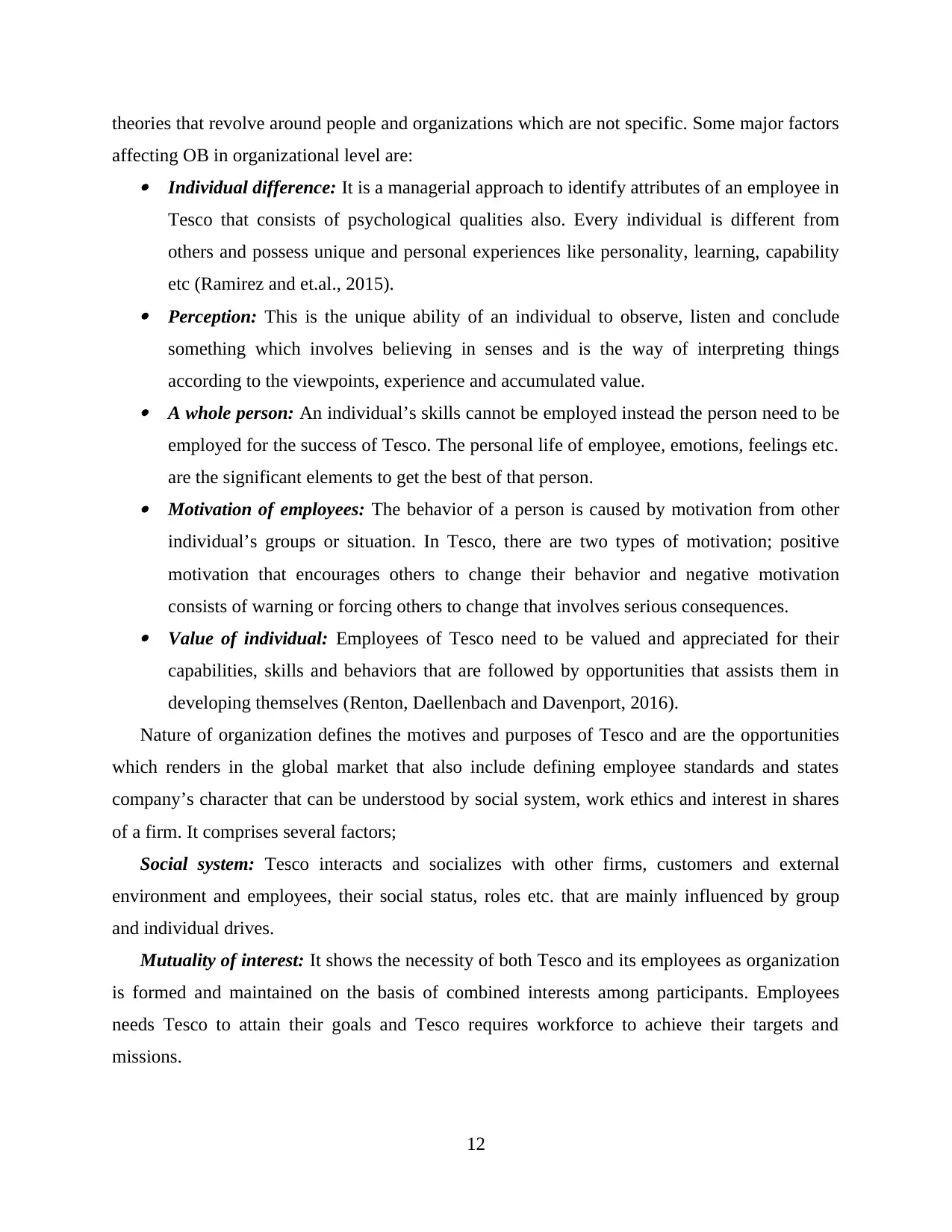
theories that revolve around people and organizations which are not specific. Some major factors
affecting OB in organizational level are: Individual difference: It is a managerial approach to identify attributes of an employee in
Tesco that consists of psychological qualities also. Every individual is different from
others and possess unique and personal experiences like personality, learning, capability
etc (Ramirez and et.al., 2015). Perception: This is the unique ability of an individual to observe, listen and conclude
something which involves believing in senses and is the way of interpreting things
according to the viewpoints, experience and accumulated value. A whole person: An individual’s skills cannot be employed instead the person need to be
employed for the success of Tesco. The personal life of employee, emotions, feelings etc.
are the significant elements to get the best of that person. Motivation of employees: The behavior of a person is caused by motivation from other
individual’s groups or situation. In Tesco, there are two types of motivation; positive
motivation that encourages others to change their behavior and negative motivation
consists of warning or forcing others to change that involves serious consequences. Value of individual: Employees of Tesco need to be valued and appreciated for their
capabilities, skills and behaviors that are followed by opportunities that assists them in
developing themselves (Renton, Daellenbach and Davenport, 2016).
Nature of organization defines the motives and purposes of Tesco and are the opportunities
which renders in the global market that also include defining employee standards and states
company’s character that can be understood by social system, work ethics and interest in shares
of a firm. It comprises several factors;
Social system: Tesco interacts and socializes with other firms, customers and external
environment and employees, their social status, roles etc. that are mainly influenced by group
and individual drives.
Mutuality of interest: It shows the necessity of both Tesco and its employees as organization
is formed and maintained on the basis of combined interests among participants. Employees
needs Tesco to attain their goals and Tesco requires workforce to achieve their targets and
missions.
12
affecting OB in organizational level are: Individual difference: It is a managerial approach to identify attributes of an employee in
Tesco that consists of psychological qualities also. Every individual is different from
others and possess unique and personal experiences like personality, learning, capability
etc (Ramirez and et.al., 2015). Perception: This is the unique ability of an individual to observe, listen and conclude
something which involves believing in senses and is the way of interpreting things
according to the viewpoints, experience and accumulated value. A whole person: An individual’s skills cannot be employed instead the person need to be
employed for the success of Tesco. The personal life of employee, emotions, feelings etc.
are the significant elements to get the best of that person. Motivation of employees: The behavior of a person is caused by motivation from other
individual’s groups or situation. In Tesco, there are two types of motivation; positive
motivation that encourages others to change their behavior and negative motivation
consists of warning or forcing others to change that involves serious consequences. Value of individual: Employees of Tesco need to be valued and appreciated for their
capabilities, skills and behaviors that are followed by opportunities that assists them in
developing themselves (Renton, Daellenbach and Davenport, 2016).
Nature of organization defines the motives and purposes of Tesco and are the opportunities
which renders in the global market that also include defining employee standards and states
company’s character that can be understood by social system, work ethics and interest in shares
of a firm. It comprises several factors;
Social system: Tesco interacts and socializes with other firms, customers and external
environment and employees, their social status, roles etc. that are mainly influenced by group
and individual drives.
Mutuality of interest: It shows the necessity of both Tesco and its employees as organization
is formed and maintained on the basis of combined interests among participants. Employees
needs Tesco to attain their goals and Tesco requires workforce to achieve their targets and
missions.
12
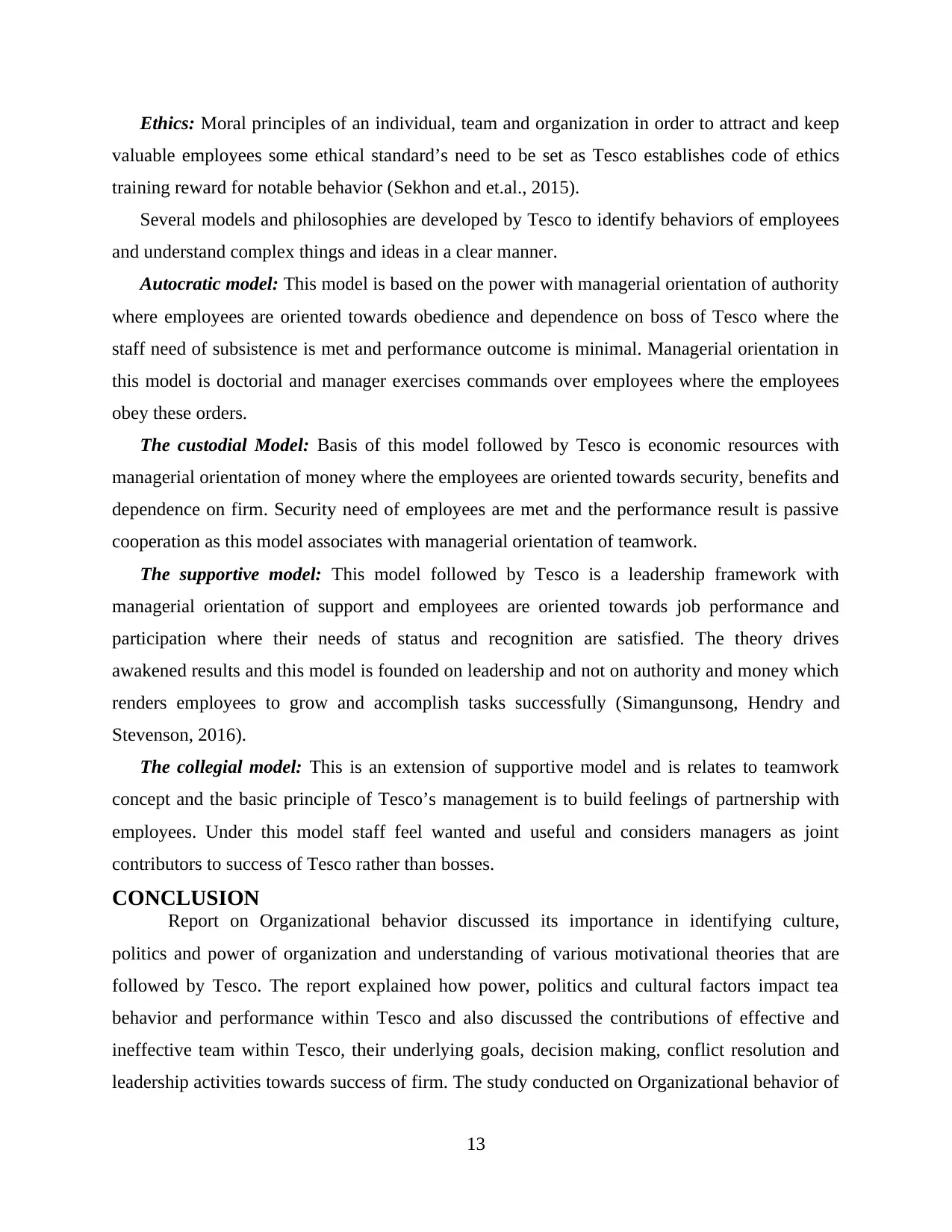
Ethics: Moral principles of an individual, team and organization in order to attract and keep
valuable employees some ethical standard’s need to be set as Tesco establishes code of ethics
training reward for notable behavior (Sekhon and et.al., 2015).
Several models and philosophies are developed by Tesco to identify behaviors of employees
and understand complex things and ideas in a clear manner.
Autocratic model: This model is based on the power with managerial orientation of authority
where employees are oriented towards obedience and dependence on boss of Tesco where the
staff need of subsistence is met and performance outcome is minimal. Managerial orientation in
this model is doctorial and manager exercises commands over employees where the employees
obey these orders.
The custodial Model: Basis of this model followed by Tesco is economic resources with
managerial orientation of money where the employees are oriented towards security, benefits and
dependence on firm. Security need of employees are met and the performance result is passive
cooperation as this model associates with managerial orientation of teamwork.
The supportive model: This model followed by Tesco is a leadership framework with
managerial orientation of support and employees are oriented towards job performance and
participation where their needs of status and recognition are satisfied. The theory drives
awakened results and this model is founded on leadership and not on authority and money which
renders employees to grow and accomplish tasks successfully (Simangunsong, Hendry and
Stevenson, 2016).
The collegial model: This is an extension of supportive model and is relates to teamwork
concept and the basic principle of Tesco’s management is to build feelings of partnership with
employees. Under this model staff feel wanted and useful and considers managers as joint
contributors to success of Tesco rather than bosses.
CONCLUSION
Report on Organizational behavior discussed its importance in identifying culture,
politics and power of organization and understanding of various motivational theories that are
followed by Tesco. The report explained how power, politics and cultural factors impact tea
behavior and performance within Tesco and also discussed the contributions of effective and
ineffective team within Tesco, their underlying goals, decision making, conflict resolution and
leadership activities towards success of firm. The study conducted on Organizational behavior of
13
valuable employees some ethical standard’s need to be set as Tesco establishes code of ethics
training reward for notable behavior (Sekhon and et.al., 2015).
Several models and philosophies are developed by Tesco to identify behaviors of employees
and understand complex things and ideas in a clear manner.
Autocratic model: This model is based on the power with managerial orientation of authority
where employees are oriented towards obedience and dependence on boss of Tesco where the
staff need of subsistence is met and performance outcome is minimal. Managerial orientation in
this model is doctorial and manager exercises commands over employees where the employees
obey these orders.
The custodial Model: Basis of this model followed by Tesco is economic resources with
managerial orientation of money where the employees are oriented towards security, benefits and
dependence on firm. Security need of employees are met and the performance result is passive
cooperation as this model associates with managerial orientation of teamwork.
The supportive model: This model followed by Tesco is a leadership framework with
managerial orientation of support and employees are oriented towards job performance and
participation where their needs of status and recognition are satisfied. The theory drives
awakened results and this model is founded on leadership and not on authority and money which
renders employees to grow and accomplish tasks successfully (Simangunsong, Hendry and
Stevenson, 2016).
The collegial model: This is an extension of supportive model and is relates to teamwork
concept and the basic principle of Tesco’s management is to build feelings of partnership with
employees. Under this model staff feel wanted and useful and considers managers as joint
contributors to success of Tesco rather than bosses.
CONCLUSION
Report on Organizational behavior discussed its importance in identifying culture,
politics and power of organization and understanding of various motivational theories that are
followed by Tesco. The report explained how power, politics and cultural factors impact tea
behavior and performance within Tesco and also discussed the contributions of effective and
ineffective team within Tesco, their underlying goals, decision making, conflict resolution and
leadership activities towards success of firm. The study conducted on Organizational behavior of
13
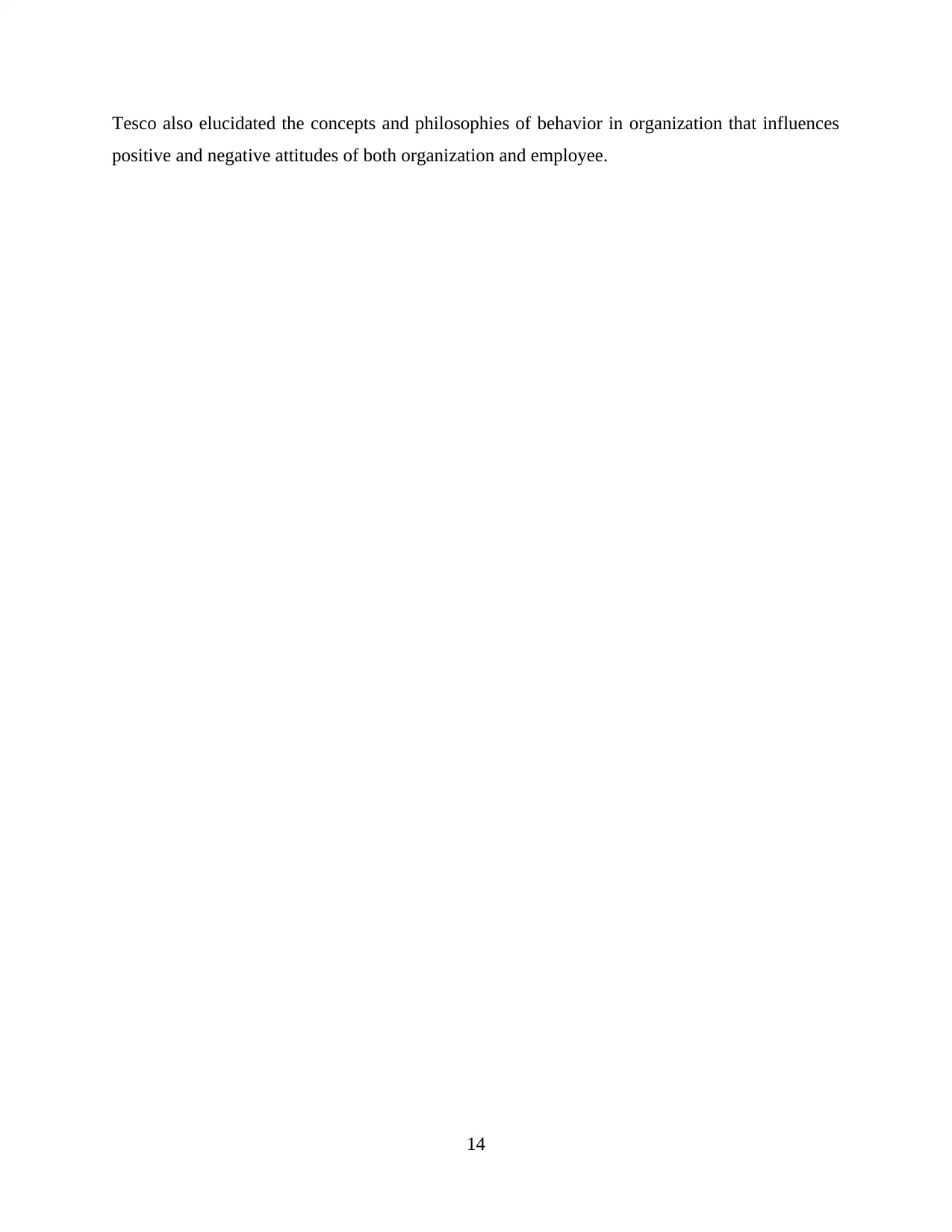
Tesco also elucidated the concepts and philosophies of behavior in organization that influences
positive and negative attitudes of both organization and employee.
14
positive and negative attitudes of both organization and employee.
14
Secure Best Marks with AI Grader
Need help grading? Try our AI Grader for instant feedback on your assignments.
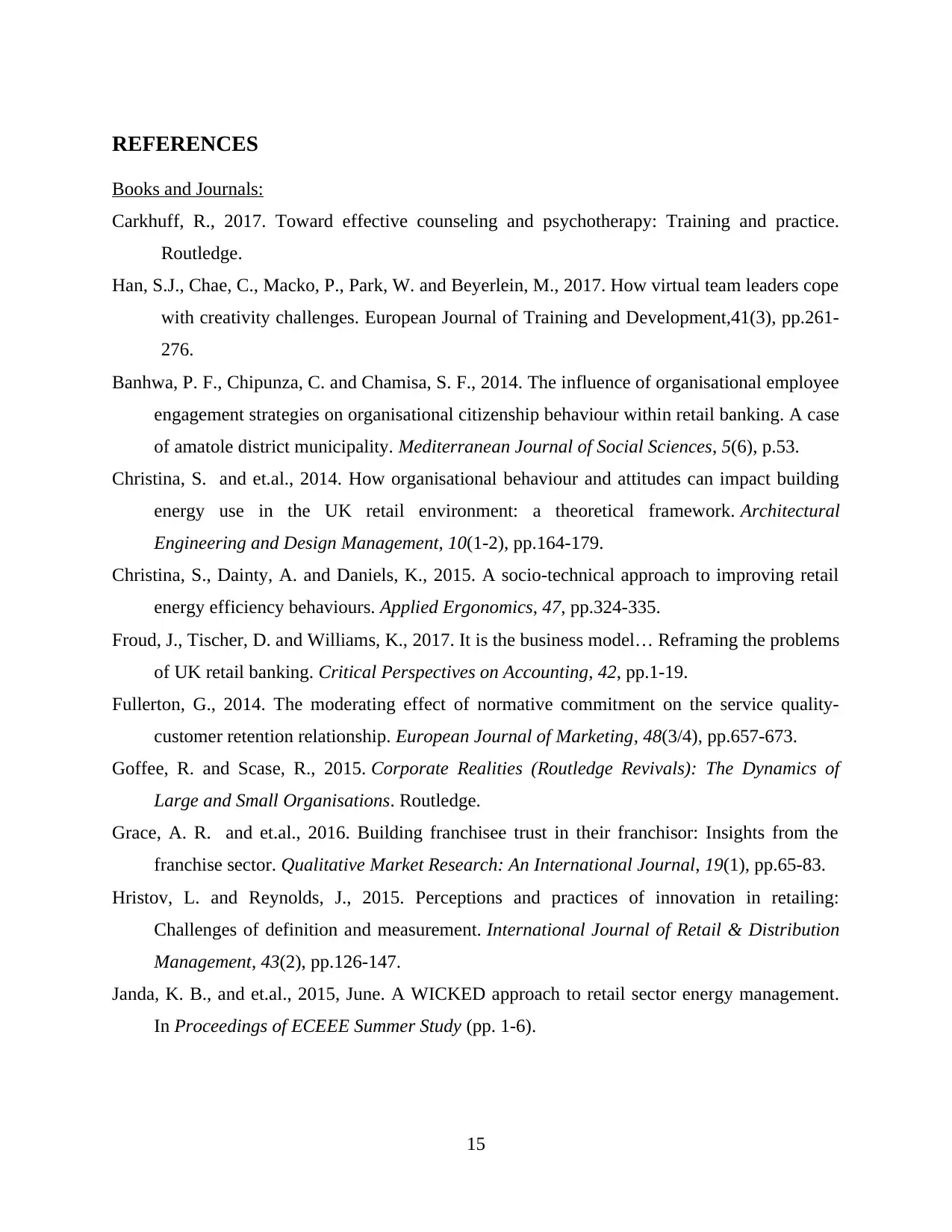
REFERENCES
Books and Journals:
Carkhuff, R., 2017. Toward effective counseling and psychotherapy: Training and practice.
Routledge.
Han, S.J., Chae, C., Macko, P., Park, W. and Beyerlein, M., 2017. How virtual team leaders cope
with creativity challenges. European Journal of Training and Development,41(3), pp.261-
276.
Banhwa, P. F., Chipunza, C. and Chamisa, S. F., 2014. The influence of organisational employee
engagement strategies on organisational citizenship behaviour within retail banking. A case
of amatole district municipality. Mediterranean Journal of Social Sciences, 5(6), p.53.
Christina, S. and et.al., 2014. How organisational behaviour and attitudes can impact building
energy use in the UK retail environment: a theoretical framework. Architectural
Engineering and Design Management, 10(1-2), pp.164-179.
Christina, S., Dainty, A. and Daniels, K., 2015. A socio-technical approach to improving retail
energy efficiency behaviours. Applied Ergonomics, 47, pp.324-335.
Froud, J., Tischer, D. and Williams, K., 2017. It is the business model… Reframing the problems
of UK retail banking. Critical Perspectives on Accounting, 42, pp.1-19.
Fullerton, G., 2014. The moderating effect of normative commitment on the service quality-
customer retention relationship. European Journal of Marketing, 48(3/4), pp.657-673.
Goffee, R. and Scase, R., 2015. Corporate Realities (Routledge Revivals): The Dynamics of
Large and Small Organisations. Routledge.
Grace, A. R. and et.al., 2016. Building franchisee trust in their franchisor: Insights from the
franchise sector. Qualitative Market Research: An International Journal, 19(1), pp.65-83.
Hristov, L. and Reynolds, J., 2015. Perceptions and practices of innovation in retailing:
Challenges of definition and measurement. International Journal of Retail & Distribution
Management, 43(2), pp.126-147.
Janda, K. B., and et.al., 2015, June. A WICKED approach to retail sector energy management.
In Proceedings of ECEEE Summer Study (pp. 1-6).
15
Books and Journals:
Carkhuff, R., 2017. Toward effective counseling and psychotherapy: Training and practice.
Routledge.
Han, S.J., Chae, C., Macko, P., Park, W. and Beyerlein, M., 2017. How virtual team leaders cope
with creativity challenges. European Journal of Training and Development,41(3), pp.261-
276.
Banhwa, P. F., Chipunza, C. and Chamisa, S. F., 2014. The influence of organisational employee
engagement strategies on organisational citizenship behaviour within retail banking. A case
of amatole district municipality. Mediterranean Journal of Social Sciences, 5(6), p.53.
Christina, S. and et.al., 2014. How organisational behaviour and attitudes can impact building
energy use in the UK retail environment: a theoretical framework. Architectural
Engineering and Design Management, 10(1-2), pp.164-179.
Christina, S., Dainty, A. and Daniels, K., 2015. A socio-technical approach to improving retail
energy efficiency behaviours. Applied Ergonomics, 47, pp.324-335.
Froud, J., Tischer, D. and Williams, K., 2017. It is the business model… Reframing the problems
of UK retail banking. Critical Perspectives on Accounting, 42, pp.1-19.
Fullerton, G., 2014. The moderating effect of normative commitment on the service quality-
customer retention relationship. European Journal of Marketing, 48(3/4), pp.657-673.
Goffee, R. and Scase, R., 2015. Corporate Realities (Routledge Revivals): The Dynamics of
Large and Small Organisations. Routledge.
Grace, A. R. and et.al., 2016. Building franchisee trust in their franchisor: Insights from the
franchise sector. Qualitative Market Research: An International Journal, 19(1), pp.65-83.
Hristov, L. and Reynolds, J., 2015. Perceptions and practices of innovation in retailing:
Challenges of definition and measurement. International Journal of Retail & Distribution
Management, 43(2), pp.126-147.
Janda, K. B., and et.al., 2015, June. A WICKED approach to retail sector energy management.
In Proceedings of ECEEE Summer Study (pp. 1-6).
15

Manika, D., Wells, V. K., Gregory-Smith, D. and Gentry, M., 2015. The impact of individual
attitudinal and organisational variables on workplace environmentally friendly
behaviours. Journal of Business Ethics, 126(4), pp.663-684.
Naidoo, M. and Gasparatos, A., 2018. Corporate Environmental Sustainability in the retail
sector: Drivers, strategies and performance measurement. Journal of Cleaner Production.
Ramanathan, U., Subramanian, N. and Parrott, G., 2017. Role of social media in retail network
operations and marketing to enhance customer satisfaction. International Journal of
Operations & Production Management, 37(1), pp.105-123.
Ramirez and et.al., 2015. Scenarios as a scholarly methodology to produce “interesting
research”. Futures, 71, pp.70-87.
Renton, M., Daellenbach, U. and Davenport, S., 2016. Finding fit: An exploratory look at SME
brand orientation and brand management in the New Zealand food and beverage
sector. Journal of Brand Management, 23(3), pp.289-305.
Sekhon and et.al., 2015. Service excellence in UK retail banking: Customers’ perspectives of the
important antecedents. International Journal of Bank Marketing, 33(7), pp.904-921.
Simangunsong, E., Hendry, L. C. and Stevenson, M., 2016. Managing supply chain uncertainty
with emerging ethical issues. International Journal of Operations & Production
Online:
Motivation theories. 2018. [Online]. Accessed through:
<https://www.tankonyvtar.hu/hu/tartalom/tamop412A/2011-0023_Psychology/030300.scorml>.
16
attitudinal and organisational variables on workplace environmentally friendly
behaviours. Journal of Business Ethics, 126(4), pp.663-684.
Naidoo, M. and Gasparatos, A., 2018. Corporate Environmental Sustainability in the retail
sector: Drivers, strategies and performance measurement. Journal of Cleaner Production.
Ramanathan, U., Subramanian, N. and Parrott, G., 2017. Role of social media in retail network
operations and marketing to enhance customer satisfaction. International Journal of
Operations & Production Management, 37(1), pp.105-123.
Ramirez and et.al., 2015. Scenarios as a scholarly methodology to produce “interesting
research”. Futures, 71, pp.70-87.
Renton, M., Daellenbach, U. and Davenport, S., 2016. Finding fit: An exploratory look at SME
brand orientation and brand management in the New Zealand food and beverage
sector. Journal of Brand Management, 23(3), pp.289-305.
Sekhon and et.al., 2015. Service excellence in UK retail banking: Customers’ perspectives of the
important antecedents. International Journal of Bank Marketing, 33(7), pp.904-921.
Simangunsong, E., Hendry, L. C. and Stevenson, M., 2016. Managing supply chain uncertainty
with emerging ethical issues. International Journal of Operations & Production
Online:
Motivation theories. 2018. [Online]. Accessed through:
<https://www.tankonyvtar.hu/hu/tartalom/tamop412A/2011-0023_Psychology/030300.scorml>.
16
1 out of 18
Related Documents
Your All-in-One AI-Powered Toolkit for Academic Success.
+13062052269
info@desklib.com
Available 24*7 on WhatsApp / Email
![[object Object]](/_next/static/media/star-bottom.7253800d.svg)
Unlock your academic potential
© 2024 | Zucol Services PVT LTD | All rights reserved.





